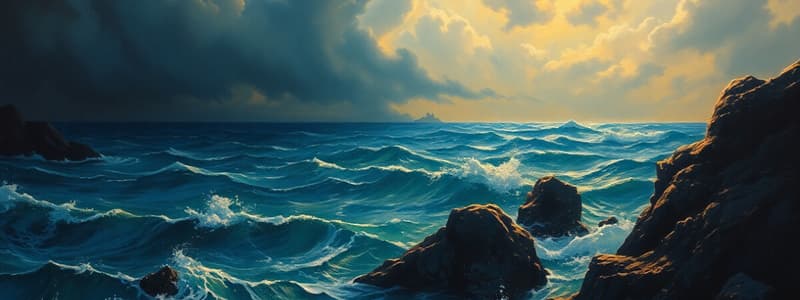Podcast
Questions and Answers
What percentage of Earth's surface is covered by water?
What percentage of Earth's surface is covered by water?
- 50%
- 71% (correct)
- 92%
- 85%
What is the average depth of the ocean?
What is the average depth of the ocean?
- 10000 m
- 3000 m (correct)
- 1500 m
- 5000 m
Why do ocean basins exist?
Why do ocean basins exist?
- Oceanic crust sits lower due to its density. (correct)
- Continental crust sinks into the mantle.
- Oceanic crust is less dense than continental crust.
- Oceanic crust is thicker than continental crust.
Which of the following accurately describes isostasy?
Which of the following accurately describes isostasy?
What is found at mid-ocean ridges?
What is found at mid-ocean ridges?
What characteristic differentiates oceanic crust from continental crust?
What characteristic differentiates oceanic crust from continental crust?
Which factor primarily influences the elevation differences between oceanic and continental crust?
Which factor primarily influences the elevation differences between oceanic and continental crust?
How does isostasy relate to the positioning of crust in the mantle?
How does isostasy relate to the positioning of crust in the mantle?
What is the primary reason that oceans would not exist without ocean basins?
What is the primary reason that oceans would not exist without ocean basins?
Which statement about mid-ocean ridges is correct?
Which statement about mid-ocean ridges is correct?
Flashcards
Ocean Coverage
Ocean Coverage
About 71% of Earth's surface is covered by water.
Average Ocean Depth
Average Ocean Depth
The average depth of the ocean is approximately 3000 meters (9800 feet).
Ocean Basin Formation
Ocean Basin Formation
Ocean basins exist because oceanic crust sits lower than continental crust, due to differences in density.
Isostasy
Isostasy
Signup and view all the flashcards
Mid-ocean ridges
Mid-ocean ridges
Signup and view all the flashcards
Why are there ocean basins?
Why are there ocean basins?
Signup and view all the flashcards
What is Isostasy?
What is Isostasy?
Signup and view all the flashcards
Mid-ocean ridge features
Mid-ocean ridge features
Signup and view all the flashcards
Ocean crust density
Ocean crust density
Signup and view all the flashcards
Ocean crust thickness
Ocean crust thickness
Signup and view all the flashcards
Study Notes
Earth's Ocean Basins
- 71% of Earth's surface is covered by water.
- Average ocean depth is 3,000 meters (9,800 feet).
- Ocean basins exist because oceanic crust sits lower than continental crust.
- Oceanic crust is thinner and denser than continental crust.
- Isostasy explains where crust sits in the mantle.
Freshwater and Salt in Oceans
- Average freshwater in oceans = <0.5%
- Processes affecting ocean water: evaporation, precipitation, runoff, melting sea ice, forming sea ice, chemical reactions at the seafloor, volcanic eruptions, and biologic interactions affect salinity.
- Salinity can vary with latitude: higher salinity in subtropical latitudes due to higher evaporation and lower temperatures.
- Salinity increases with depth in equatorial regions, but salinity decreases with depth in higher latitudes.
Ocean Temperature
- Ocean temperature decreases with depth, there is a thermocline at around 2000 meters.
- The surface water is warmer.
Continental Margins
- Margins are the edge of the continent.
- Active margins are shaped by tectonic processes.
- Passive margins are far from plate boundaries and shaped by tidal and stream processes.
- Features like submarine canyons are caused by concentrated turbidity currents.
- Turbidity currents are sediment-laden currents that carve out canyons.
- Turbidites result when water recedes over many years.
Earthquakes
- Major earthquake belts are found at plate boundaries (mostly transform plate boundaries).
- Examples of major earthquakes: San Francisco (1906), Loma Prieta (1989), Northridge (1994), Haiti (2010), Haiti (2021), Japan (2011), Ridgecrest (2019).
- Earthquakes are the sudden movement of one rock block slipping past another along a fault.
- Fault blocks are the sections of rock that slip past each other during an earthquake.
- Faults are usually locked until the stress overcomes friction.
- Seismic waves radiate from the focus of an earthquake.
- Epicenter is directly above the focus.
- Types of faults: strike-slip and dip-slip.
- Different scales used for measuring earthquakes: Richter, Mercalli, and Moment magnitude.
- Different elements can be used for dating rocks.
Intrusive Igneous Bodies
- Intrusive igneous rocks are formed when magma rises through existing solid rock.
- Some examples are plutons (large, blob-shaped intrusive bodies), batholiths (very large plutons), dikes (narrow, linear bodies that cut across preexisting layers), and sills (horizontal magma flows).
Volcanoes
- Volcanoes erupt because gas is trapped in the liquid magma, like a bottle of champagne.
- Lava, molten rock, pours out when pressure releases.
- Pyroclastics, such as ash, cinder, and volcanic bombs, are ejected from the volcano.
Mass Movements
- Mass movement is the downslope movement of rock and soil primarily due to gravity.
- The materials can often be described as a "slurry" similar to wet concrete when moving downhill.
- Factors affecting slope steepness and water can trigger mass movements.
Landscapes by Water
- Rivers transport sediment as a dissolved load (ions), a suspended load (small particles), and a bed load (larger particles).
- River discharge is the amount of water that is moved in one area (ft³/s).
- Sediment deposition occurs at the river mouth, at beaches, and deltas.
- Stream valleys such as V-shaped valleys are created by downcutting.
- Wide valleys with flat floors result from less downcutting and more mass movement.
- Meandering streams are common farther from the source and have wide floodplains.
- Braided streams are characterized by crisscrossing channels, and often appear in mountainous or desert areas.
- Levees and dams are artificial structures to control rivers.
Studying That Suits You
Use AI to generate personalized quizzes and flashcards to suit your learning preferences.



